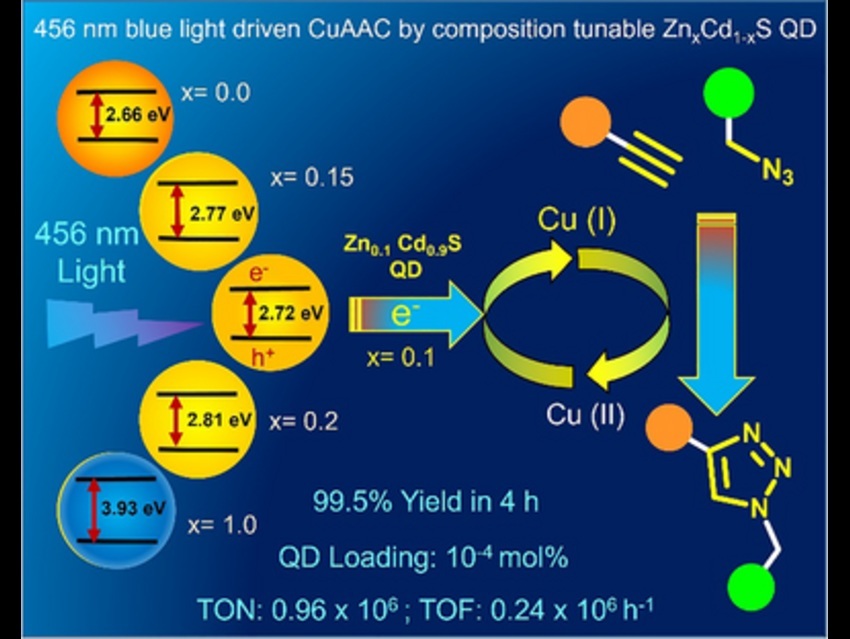Traditional photocatalysts used for copper-catalyzed azide–alkyne cycloaddition (CuAAC), a key reaction in triazole synthesis, often suffer from poor light absorption, slow reaction rates, and limited recyclability. Md. Firoj Hossain, University of North Bengal, Raja Rammohunpur, Darjeeling, West Bengal, India, Satyapriya Bhandari, Kandi Raj College, affiliated with the University of Kalyani, Murshidabad, West Bengal, India, and colleagues aimed to address these issues by designing better photocatalysts that work efficiently under visible light.
For the first time, ZnxCd₁₋ₓS quantum dots (QDs) have been used to drive CuAAC reactions under visible light. The team showed that fine-tuning the composition of these QDs dramatically improves reaction speed, yield, and recyclabilit, making them powerful tools for green chemistry and scalable synthesis.
ZnxCd₁₋ₓS QDs were synthesized with varying zinc content (x = 0 to 1) using a controlled chemical method by mixing zinc and cadmium precursors with sulfur sources and stabilizers to form uniform nanoparticles. Characterization through UV–vis and photoluminescence revealed that increasing zinc content caused a blue shift in absorption and emission, with Zn₀.₁Cd₀.₉S showing a bandgap of 2.72 eV, ideal for absorbing 456 nm blue light. X-ray diffraction and electron microscopy confirmed the structural integrity and uniform size (~5 nm) of the QDs.
These QDs were tested as photocatalysts in the CuAAC reaction between phenyl acetylene and benzyl azide under mild conditions (CuSO₄·5H₂O 5 mol%, QDs 1 × 10⁻⁴ mol%, CHCl₃–H₂O 1:1, room temperature, air, 456 nm light). Zn₀.₁Cd₀.₉S QDs delivered the best performance, achieving 99.5% yield in just 4 hours under blue LED light and maintaining 81% yield after 10 cycles, outperforming conventional CdS QDs and other compositions.
Mechanistically, light excites the QDs, enabling them to transfer electrons to copper(II), reducing it to the active copper(I) species that drives the cycloaddition to form triazoles. Control experiments confirmed that light, QDs, and copper are all essential for the reaction to proceed.
This work introduces a new class of efficient, reusable, and scalable photocatalysts for organic synthesis. Zn₀.₁Cd₀.₉S QDs could be used in pharmaceutical chemistry, materials science, and bioorthogonal reactions. Their stability and performance open doors to broader applications in light-driven catalysis and sustainable manufacturing.
- Composition-Engineered Quantum Dots for Visible Light-Driven Copper-Catalysed Click Chemistry
Sovan Dey, Santanu Dolai, Anup Barman, Ram N. Yadav, Md. Firoj Hossain, Satyapriya Bhandari
ChemCatChem 2025
https://doi.org/10.1002/cctc.202501315




